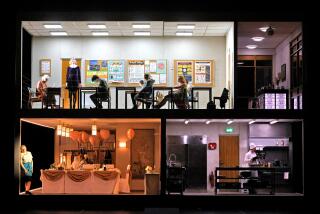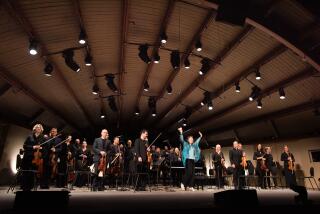Perahia’s technique and emotion shine through
- Share via
WHO among our working concert pianists will be considered legends 50 years from now? Short of boarding a time machine, it’s almost impossible to say, for there are too many superhumanly gifted candidates on the boards nowadays to sort out.
But one can say that Murray Perahia is on many short lists. While he doesn’t have the overpowering personality of a Horowitz or a Rubinstein or a Gould, Perahia probably belongs in the category of high priests, those who seem to serve great music more than they call attention to themselves. Unlike those who want to knock you over early with the athletic blockbusters of the 19th century, Perahia made his first big impression in Mozart, then expanded into the Romantics, and after a serious thumb injury (now fully healed) ushered in a period of reflection, he went back to Bach for repertoire and inspiration.
The programming of Perahia’s recital Tuesday night in the Renee and Henry Segerstrom Concert Hall reinforced this self-effacing seriousness, with mostly revered Germanic names and one eminently respectable Pole on the menu. It was an evening for connoisseurs of traditionally structured recital programs, and Perahia delivered with his customary thoughtful probing and fearless technique.
One nagging obstacle, though, may have been this new venue.
From the opening notes, Perahia’s Steinway sounded disturbingly metallic from the orchestra floor, with treble notes blurring in the over-reverberant acoustic (all of the reverberation doors were opened to some degree) -- and the timbre did not warm up much even as the repertoire turned Romantic. In J.S. Bach’s Partita No. 2, whatever clarity there was in Perahia’s refined, somewhat inward, not very rhythmic conception was compromised by the foggy acoustics, each note in the Sarabande adrift in a cloud.
Instead of offering familiar Beethoven, Perahia chose to illuminate the relatively underexposed Sonata No. 15 -- nicknamed “Pastoral” -- which was written right after the “Moonlight” Sonata yet stands entirely apart with its more or less formal four-movement structure and quirky, unpredictable humor. Perahia displayed a sure grip on the architecture of each movement, turning on the power in sparing proportions when needed.
Later he escalated toward real eloquence in parts of Brahms’ Six Pieces, Opus 118, with long, sustained swells in volume in the second Intermezzo, plenty of fireworks and all kinds of subtle dynamic adjustments in the Ballade.
Perahia’s 2001 Sony recording of all the Chopin etudes was an emotionally charged, technically dazzling thing, and he offered two brief souvenirs from that project: a gorgeously phrased Opus 25, No. 1 (“Aeolian Harp”), and a jaw-dropping Opus 10, No. 4. His rendition of the Chopin Ballade No. 3 is evolving nicely -- it’s now more openly flamboyant in the showier passages and more aristocratic in others -- and he added the Nocturne No. 4 in F (along with Schumann’s butterfly-like “Traumes wirren”) as an encore.
As a Chopin pianist, Perahia is knocking on the door of greatness, and one imagines that his insights will only grow deeper.
More to Read
The biggest entertainment stories
Get our big stories about Hollywood, film, television, music, arts, culture and more right in your inbox as soon as they publish.
You may occasionally receive promotional content from the Los Angeles Times.










